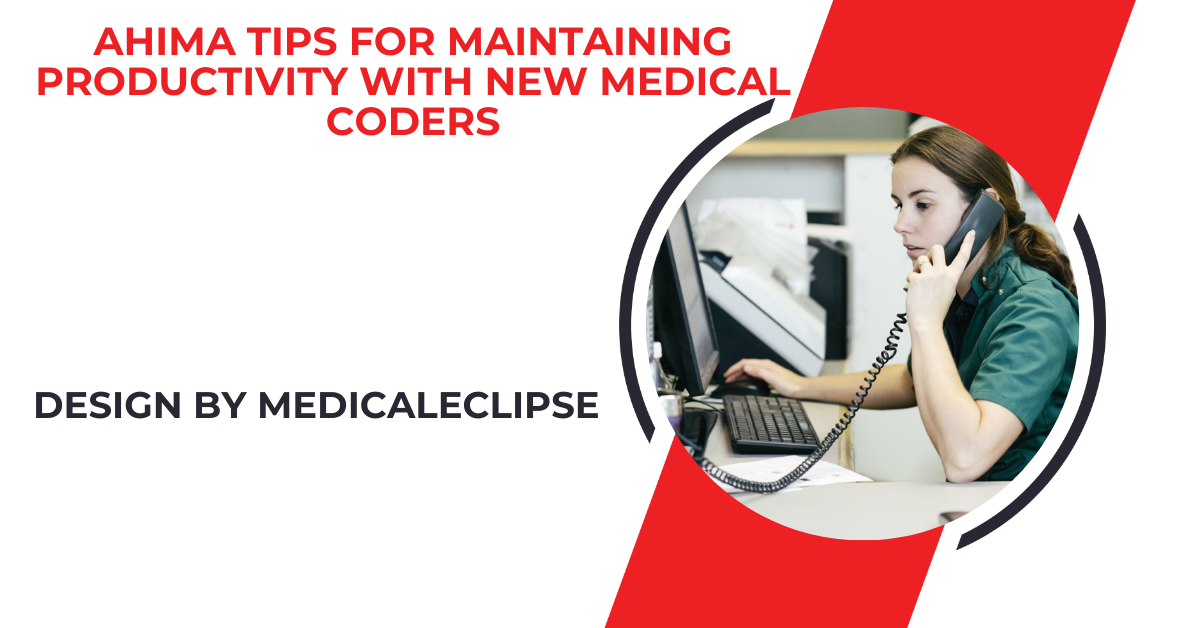AHIMA offers strategies like structured onboarding, certifications, and technology to boost productivity with new medical coders.
The healthcare industry relies heavily on accurate and efficient medical coding to ensure smooth billing, reimbursements, and patient care. With the growing demand for skilled coders, the American Health Information Management Association (AHIMA) offers invaluable tips for organisations looking to integrate new medical coders while maintaining productivity.
In this article ,Training and onboarding new coders can be a challenge, but with the right strategies, healthcare providers can streamline this process and optimise performance.
Create a Thorough Onboarding Program:

One of AHIMA’s top recommendations is to establish a comprehensive and structured training program for new medical coders. Without a solid training program in place, new coders might feel overwhelmed, leading to decreased productivity and an increased likelihood of errors.
Key Elements of a Successful Training Program:
Start with the fundamentals:
Ensure that coders have a strong understanding of the basics, such as medical terminology, anatomy, and physiology, before diving into advanced coding concepts. Having a good foundation will help coders be more confident when they encounter complex coding scenarios.
Introduction to coding systems:
Train coders extensively on the key coding systems—ICD-10-CM, ICD-10-PCS, CPT, and HCPCS. Understanding the structure, rules, and guidelines of these systems is essential for accurate coding. Break down each coding system into modules, allowing coders to master one system before moving on to the next.
Provide real-world coding scenarios:
Include practice with real or simulated patient charts. This not only reinforces theoretical knowledge but also helps coders get used to navigating different types of clinical documentation and identifying key pieces of information for accurate coding.
Utilise AHIMA resources:
AHIMA offers various online courses, webinars, and certification programs designed to keep coders updated on industry trends, coding rules, and best practices. Incorporating these into your training program ensures that your new coders stay aligned with industry standards.
Assigning Mentorship for New Coders:
- Mentorship programs are incredibly beneficial for new coders.
Having a seasoned coder serve as a mentor allows new coders to ask questions, get personalised guidance, and receive feedback on their performance. Mentors can also provide insights into organisational workflows and coding standards, ensuring that new coders are familiar with the unique requirements of your facility.
- Shadowing opportunities:
Encourage new coders to shadow experienced coders, which allows them to observe coding in real-time and understand how to manage their workload effectively. It also gives them the chance to learn how to resolve complex coding queries.
A well-structured training program is an investment that ensures new coders can transition smoothly and efficiently into their roles while maintaining high accuracy levels.
Leverage ANIMation Programs:
Encouraging new coders to obtain AHIMA certifications like the Certified Coding Specialist (CCS) or Certified Coding Associate (CCA) is crucial. These certifications ensure coders are well-versed in healthcare coding standards, which reduces the learning curve and increases accuracy.
AHIMA-certified coders are more likely to adhere to best practices, which can prevent costly errors, improve claim approval rates, and enhance the overall productivity of your coding department.
Provide Access to AHIMA Resources and Tools:
AHIMA offers a wide range of tools and resources that can help new coders stay up-to-date with the latest industry changes and coding updates. Organizations should offer access to:
AHIMA’s Code-Check Tool: Ensures that the latest coding guidelines and updates are used, minimising errors.
- E-learning Programs: Help coders to refine their skills and gain specialised knowledge in areas such as outpatient coding or inpatient procedures.
Providing these resources empowers coders to stay proficient and up-to-date, reducing the time spent researching codes and improving overall productivity.
Foster a Supportive Work Environment:
Creating a supportive and collaborative work environment is key to helping new coders succeed. Pair new coders with experienced mentors who can provide guidance, answer questions, and offer real-time feedback.
Having someone to consult can help prevent common coding mistakes and increase coding speed. Additionally, creating a culture of continuous learning encourages coders to ask questions and seek clarification, leading to more accurate work and higher productivity levels.
Also Read: Do Emergency One Accept Medicaid – A Comprehensive Guide for Medicaid Users!
Utilise Technology to Enhance Coding Efficiency:
Modern coding software and AI-based solutions can significantly improve productivity by automating repetitive tasks and reducing manual data entry. AHIMA recommends adopting technologies like:
- Computer-Assisted Coding (CAC): Helps coders quickly and accurately assign codes by automatically suggesting codes based on documentation.
- Natural Language Processing (NLP): Streamlines the extraction of clinical data, allowing coders to focus on more complex coding tasks.
Leveraging these technologies enables coders to work more efficiently, reduce errors, and improve the accuracy of medical claims.
Encourage Continuous Education and Training:
Healthcare regulations, coding standards, and reimbursement policies are constantly evolving. To ensure that new medical coders remain productive, AHIMA emphasises the importance of ongoing education and training.
Employers should offer opportunities for new coders to participate in:
- Workshops and Webinars: These are great ways to learn about recent coding changes and best practices.
- Professional Development Programs: Encourage coders to pursue additional certifications or specialise in particular areas of coding.
By staying current on the latest developments, new coders can avoid costly mistakes and process claims faster, contributing to higher productivity.
Set Realistic Productivity Goals and KPIs:
Setting achievable productivity goals is essential when working with new coders. AHIMA suggests establishing Key Performance Indicators (KPIs) that track productivity without sacrificing accuracy. Focus on metrics such as:
- Codes per hour: Measure the number of codes processed.
- Accuracy rate: Track the percentage of error-free claims.
- Turnaround time: Monitor the time it takes to complete coding tasks.
Providing regular feedback on these KPIs helps new coders understand where they need to improve and allows them to gradually increase their output without feeling overwhelmed.
FAQs:
- Why is a structured onboarding program important for new medical coders?
A structured onboarding program helps new coders acclimate faster, reduces errors, and boosts productivity from the start.
- How do AHIMA certifications benefit new medical coders?
AHIMA certifications ensure coders are well-versed in healthcare coding standards, improving accuracy and reducing the learning curve.
- What resources should employers provide to new coders to stay updated?
Employers should offer access to AHIMA’s Code-Check tool, e-learning programs, and coding updates to help new coders stay proficient.
- How can technology improve coding efficiency for new coders?
Tools like Computer-Assisted Coding (CAC) and Natural Language Processing (NLP) automate tasks, reducing errors and speeding up coding processes.
- Why is continuous education important for medical coders?
Continuous education helps coders stay current with evolving regulations and standards, preventing mistakes and maintaining high productivity.
Conclusion:
AHIMA’s tips for maintaining productivity with new medical coders emphasise the importance of structured onboarding, certification programs, and continuous education. Utilising technology and fostering a supportive work environment further enhances accuracy and efficiency. These strategies help new coders adapt quickly and maintain high performance while reducing errors in the coding process.
Related Post
- What Is Medicaid Exclusion For Funeral Plans – Benefits of Medicaid Funeral Exclusions!
- Banner Desert Medical Center – Trusted Care in Arizona!
- Why Cranberry Femine Health – The Ultimate Natural Wellness Guide for Women!
- What Is The Best Peptide For Bone Health – A Comprehensive Overview!
- Why Is Signify Health Calling Me – Understanding the Purpose Behind the Call!

Leave a Reply